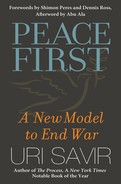INTRODUCTION
A New Model
IMAGINE COUNTRIES A AND B MAKING EFFORTS TO MOVE beyond bitter conflicts and toward a peaceful coexistence. The atmosphere at the negotiating table is stiff with hatred and suspicion; thousands of citizens on both sides of the border have fled, been killed, or been deported during the conflict. Only a slim majority of either society yearns for a compromising peace. But delegates, endeavoring to demonstrate such compromise, meticulously negotiate a new border.
Negotiations emphasize traditional peacemaking parameters relating to the deployment of armies away from the border, the monitoring of troop deployment, and the stationing of UN peacekeeping forces along the border. The countries establish diplomatic and commercial relations and facilitate visitation rights for their respective citizens. The international community provides aid to both countries, simultaneously applauding the success of the agreement. Rumors drift around the globe that the leaders of the two countries are likely candidates for the Nobel Peace Prize.
The above scenario paints a promising and familiar picture. Let us continue on this hypothetical path with the following realistic developments occurring in both countries:
- Opposition groups protest “peace,” threatening the use of violence both domestically and internationally.
- Mainstream media outlets are skeptical of the “enemy’s” motivation and present public opinion polls that illustrate growing opposition toward the agreements.46
- Militaries accuse one another of border troop deployment beyond the quotas allowed by the agreement.
- Scandals involving corruption and the misuse of aid money are reported, weakening the support of the disillusioned constituency.
- Opposition parties accuse the political leadership of defeatism and corruption.
- Terror attacks are launched by members of country B against civilians in country A, arousing military retaliation and halting economic cooperation.
- The UN Security Council convenes to attempt to enforce the original agreement.
- Terrorism continues and country A occupies territory whence terror is launched.
- Attacks and counterattacks become daily events.
- End of peace.
Such a scenario is not farfetched; indeed, it features actual events from several international situations. Years are spent negotiating hundreds of pages of agreements, outlining new borders and intended diplomatic and commercial relations. More time is squandered in deliberating troop deployment, and intelligence technology is installed for its monitoring. Such agreements present a combination of legal jargon and technical, security, and diplomatic arrangements. Yet, even with all the meticulous work that negotiations of this nature entail, neither peace nor stability can be ensured. Peace applies to two societies, not simply to two armies and two foreign ministries.
Our theoretical scenario can be transformed into a different picture by adding elements after the peace agreement is signed:
- The building of roads and railways between country A and B is planned and implemented, creating jobs in the short term 47 and interconnectivity in the long term. Jobs are channeled to more needy populations.
- Both countries work to establish tourism infrastructure within the border region and introduce a parallel marketing campaign to attract tourists to special cross-border attractions.
- A sister-city program is implemented to link municipalities, businesses, civil society organizations, and youth exchange programs.
- Both countries establish cross-border qualified industrial zones for joint businesses, enhancing joint export to Europe, the United States, and Asia.
- Joint media, films, and documentaries are released to generate a more positive peace culture.
- A joint public relations campaign is implemented to strengthen the voice of the latent and silent peaceful majority.
- A vast program of security cooperation is implemented, including joint forces against terrorism.
With these cooperative elements in place, peace has a better chance of being stable and sustainable. However, to move effectively from security-centric concepts to joint social, economic, and cultural components, we must systematically analyze the main areas of participatory peace and decide how to treat them during negotiations, agreements, and implementation. In other words, we need a new peacemaking model that treats these issues as central to the process instead of peripheral.
This book presents just such a model, starting with the four pillars that must be central to every peace process:
- Participatory peace and glocalization. A process of decentralization based on building a bridge between global opportunities and local players, particularly through city-to-city interactions and youth empowerment. 48
- Peace ecology. The movement from a culture of war to a culture of peace based on common values, tolerance, and coexistence.
- Peacebuilding. The creation of joint cross-border ventures in the political, economic, cultural, and social spheres.
- Creative diplomacy. The use of innovative approaches to past problems, focusing on what both sides stand to gain rather than on what concessions each side will have to make.
These pillars are discussed in detail in the following chapters, along with practical guidance for implementation and real-life case studies that integrate these concepts into peacemaking initiatives.
